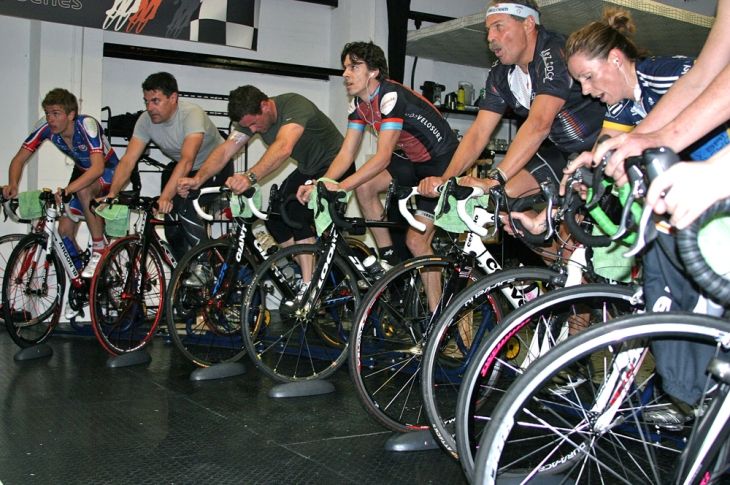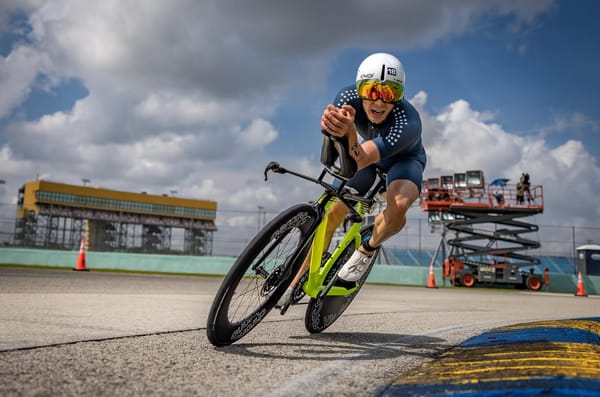Submitting to the Higher Power – Smart Cycling Training
Editors Note: After agreeing to cycle in a team at this weekend's Port Macquarie 70.3 six weeks ago I had to figure out very quickly how to go from four months of no training to something that may or may not resemble a 2:30 90km bike leg. Now I won't know until this Sunday where [&hellip

Editors Note: After agreeing to cycle in a team at this weekend’s Port Macquarie 70.3 six weeks ago I had to figure out very quickly how to go from four months of no training to something that may or may not resemble a 2:30 90km bike leg. Now I won’t know until this Sunday where I am at (and to be honest my money is on coming up short) but I have seen the light! I have discovered cycling on a Computrainer. I am hooked! Not only do I feel stronger than I have ever felt (still not sure I am going to crack 2:30 with only 6 weeks training) but a surprising side effect is that my running has become stronger. I am not saying I am running faster but with an average of 1.5 short runs a week I am maintaining speed and power like never before.
I am no Robinson Crusoe but there would have to be around 95%+ of the triathlete population that know very little about training with power. So all of you who are already training with power remember that a majority don’t and have very little knowledge in this area so this article is aimed at that demographic.
Since I started training on a Computrainer I have been asking around more than normal about training with power. A large number of successful age groupers (and pros but I am trying to keep this ‘realistic’ with what us age groupers can achieve) have said ‘How do you think I train?’. This list reads like a who’s who of age group cereal podium exponents. Whilst keeping age groupers in our sights I did listen to Pete Jacobs ‘power debrief’ at the SRAM/QUARQ expo in Kona. It was incredibly interesting. Once again it highlighted the upside of training with power. I also found this article from 2001 that probably resonates with most of us more than anything.
So with a bit of asking around I came upon Turbo Studio in Sydney. I asked them if they could put an article together that gives age groupers a 101 on training with power. We will follow this up with more in-depth articles but this is a good start. I have also added links below the article to studios in Melbourne and Brisbane.
Basically if you work full time (or not), want to cycle and run faster and do this more efficiently then you need to seriously look at how to get on a Computainer (or a Watt Bike).
The power meter for bicycles has been around since the 1980’s when Greg Lemond (first American to win the Tour de France) started training and racing with one.
Basically, a power meter measures the output of energy on a bike in terms of watts. By using various testing protocols, a baseline can be established and different zones are determined to prescribe training. This plays a crucial role in a multitude of events as by analysing post race/training files, a determination can be made for future positive development.
Whether it is the price that stops people from owning a power meter or the lack of knowledge, the truth is you will get better on the bike while training and racing with power!!! As much money as people spend on ‘Bling’ in sport, why would you not want to invest in a method of training that will actually improve your fitness and race speed?
There are more and more power meters entering the market every year as technology dictates. At first, it was a “crank based” power meter (SRM), soon followed by a bottom bracket power meter (ergomo pro), then Cycleops came out with a rear hub unit that would measure and record how much suffering you were putting yourself through.
In the mix also was a unit which could be attached and calibrated to your existing cranks (Quarq). Of course, somewhere in there, a “wind sensing” power meter came out which would take outside temperature, wind speed, and then put it in a formula to give an
estimateof your watts and last, but not least we are anxiously waiting for pedal based power to come to the public. (Who knows how long until the debut of Garmin Vector?)
**As of writing this article, Rotor has also announced they are coming out with a new crank based PM and it looks promising.**
Another method of measuring/training with power is by utilising the experience and knowledge housed within cycling studios. Studios often use Computrainers which are state of the art computerised ergometers. Studios can provide customised training sessions based on ‘power zones’ meaning that when you approach hills or descents, the resistance on the trainer changes requiring of you a change in your power output. Interval training at its best! The thinking has been done for you, no distractions and no external interferences. It’s a load-controlled session where you simply use varying amounts of force in your pedal stroke to meet the resistance fed to your back wheel. There’s simply no hiding here.
With the purchase price of a Computrainer running along the same price lines as a good power meter, a studio is a very good option to test and gauge future gains.
The advantages to this are numerous:
- Training is inside so you don’t need to worry about traffic, weather, or lack of daylight.
- A studio will provide testing and evaluation of your cycling output. Sessions are designed to improve you in a sound and methodical way.
- If you have a race coming up, you can ride the course ahead of time. If you are travelling to a big race (say Ironman Australia, Auckland ITU, Ultimate Batemans Bay, Kona, etc…) the course can be converted into a rideable session for you. You can then rock up to your studio and pre-ride the course as many times as you want. Thereby come race day, you know when and where those hills are coming and will be able to pace correctly to set up a good run.
- You can bring your mates in and have a quality group ride that is fun and nobody gets dropped!
- The education you will receive while training at Turbo Studio is priceless. You will not only learn how to train different systems of your body, but the why.
So of course with triathletes priding their selves on being ‘cutting edge’, they also have adopted training and racing with these units to get them faster. Not only that, you can utilise power meter to gauge your output and pace the bike portion in a way to not only obtain a good time on the bike, but
also save some legs for a good run.Attacking the hills, playing ‘calf tag’ with the athlete riding next to you and playing ‘machismo’ every time you came by your supporters who are yelling encouragement (by unnecessary accelerations) have given way to smooth and steady efforts to prevent ‘burning unwanted matches’.
Power meters provide instant feedback to the rider about their performance and measure their actual output; whereas heart rate monitors measure the physiological effect of effort and therefore ramp up more slowly. Thus, an athlete performing ‘interval’ training while using a power meter can instantly see that they are producing 300 watts, for example, instead of waiting for their heart rate to climb to a certain point. In addition, power meters measure the force that moves the bike forward multiplied by the velocity, which is the desired goal.
This has two significant advantages over heart rate monitors:
- An athlete’s heart rate may remain constant over the training period, yet their power output is declining, which they cannot detect with a heart rate monitor;
- While an athlete who is not rested or not feeling entirely well may train at their normal heart rate, they are unlikely to be producing their normal power—a heart rate monitor will not reveal this, but a power meter will. Further, power meters enable riders to experiment with cadence and evaluate its effect relative to speed and heart rate.
- Sessions at Turbo Studio can be used as a “on the road” wind tunnel. Meaning that the athlete can experiment with different positions/equipment to find the “Nirvana” of the relation between aerodynamics and max wattage output.
Having a power meter will not instantly make you an overnight success. Learning
how and whyto use one will insure that you are not just purchasing a high priced cycle computer. It takes work and dedication (as with everything else in life) but will pay great dividends in the end. This is where TRAINING AT A STUDIO AND WITH A COACH that understands working with power meters and reading power files can help you reach new heights in your cycling whatever your goals.





